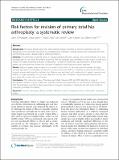| dc.contributor.author | Prokopetz, Julian James Zuba | |
| dc.contributor.author | Losina, Elena | |
| dc.contributor.author | Bliss, Robin L | |
| dc.contributor.author | Wright, John | |
| dc.contributor.author | Baron, John A | |
| dc.contributor.author | Katz, Jeffrey Neil | |
| dc.date.accessioned | 2013-04-26T13:38:39Z | |
| dc.date.issued | 2012 | |
| dc.identifier.citation | Prokopetz, Julian James Zuba, Elena Losina, Robin L. Bliss, John Wright, John A. Baron, and Jeffrey Neil Katz. 2012. Risk factors for revision of primary total hip arthroplasty: A systematic review. BMC Musculoskeletal Disorders 13:251. | en_US |
| dc.identifier.issn | 1471-2474 | en_US |
| dc.identifier.uri | http://nrs.harvard.edu/urn-3:HUL.InstRepos:10588032 | |
| dc.description.abstract | Background: Numerous papers have been published examining risk factors for revision of primary total hip arthroplasty (THA), but there have been no comprehensive systematic literature reviews that summarize the most recent findings across a broad range of potential predictors. Methods: We performed a PubMed search for papers published between January, 2000 and November, 2010 that provided data on risk factors for revision of primary THA. We collected data on revision for any reason, as well as on revision for aseptic loosening, infection, or dislocation. For each risk factor that was examined in at least three papers, we summarize the number and direction of statistically significant associations reported. Results: Eighty-six papers were included in our review. Factors found to be associated with revision included younger age, greater comorbidity, a diagnosis of avascular necrosis (AVN) as compared to osteoarthritis (OA), low surgeon volume, and larger femoral head size. Male sex was associated with revision due to aseptic loosening and infection. Longer operating time was associated with revision due to infection. Smaller femoral head size was associated with revision due to dislocation. Conclusions: This systematic review of literature published between 2000 and 2010 identified a range of demographic, clinical, surgical, implant, and provider variables associated with the risk of revision following primary THA. These findings can inform discussions between surgeons and patients relating to the risks and benefits of undergoing total hip arthroplasty. | en_US |
| dc.language.iso | en_US | en_US |
| dc.publisher | BioMed Central | en_US |
| dc.relation.isversionof | doi:10.1186/1471-2474-13-251 | en_US |
| dc.relation.hasversion | http://www.ncbi.nlm.nih.gov/pmc/articles/PMC3541060/pdf/ | en_US |
| dash.license | LAA | |
| dc.subject | Total hip arthroplasty | en_US |
| dc.subject | Revision | en_US |
| dc.subject | Failure | en_US |
| dc.subject | Risk factor | en_US |
| dc.subject | Aseptic loosening | en_US |
| dc.subject | Infection | en_US |
| dc.subject | Dislocation | en_US |
| dc.subject | Systematic review | en_US |
| dc.title | Risk factors for revision of primary total hip arthroplasty: A systematic review | en_US |
| dc.type | Journal Article | en_US |
| dc.description.version | Version of Record | en_US |
| dc.relation.journal | BMC Musculoskeletal Disorders | en_US |
| dash.depositing.author | Katz, Jeffrey Neil | |
| dc.date.available | 2013-04-26T13:38:39Z | |
| dc.identifier.doi | 10.1186/1471-2474-13-251 | * |
| dash.contributor.affiliated | Wright, John | |
| dash.contributor.affiliated | Prokopetz, Julian | |
| dash.contributor.affiliated | Losina, Elena | |
| dash.contributor.affiliated | Katz, Jeffrey | |


